Lithuanian cuisine
| Part of a series on the |
| Culture of Lithuania |
|---|
 |
| History |
| People |
| Languages |
|
Mythology and folklore |
| Cuisine |
| Festivals |
| Religion |
| Art |
| Literature |
|
Music and performing arts |
| Sport |
|
Monuments |
|
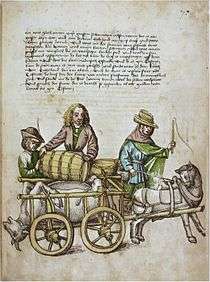
Lithuanian cuisine features products suited to the cool and moist northern climate of Lithuania: barley, potatoes, rye, beets, greens, berries, and mushrooms are locally grown, and dairy products are one of its specialties. Various ways of pickling were used to preserve food for winter. Soups are extremely popular, and are widely regarded as the key to good health. Since it shares its climate and agricultural practices with Northern Europe, Lithuanian cuisine has much in common with its Baltic neighbors and, in general, northern countries. Longlasting agricultural and foraging traditions along with variety of influences during the country's long, difficult and interesting history formed a Lithuanian cuisine.
German traditions have had an influence on Lithuanian cuisine, introducing pork and potato dishes, such as potato pudding (kugelis or kugel) and intestines stuffed with mashed potato (vėdarai), as well as the baroque tree cake known as Šakotis. Lithuanian noblemen usually hired French chefs - French cuisine influence came to Lithuania it this way.[1] The most exotic influence is Eastern (Karaite) cuisine, and the dish kibinai which got popular in Lithuania. Lithuanians and other nations which lived in Grand Duchy of Lithuania also share some dishes and beverages. Lithuanian cuisine also influenced Polish and Ruthenian cusines.
Despite the apparent richness of the cuisine, Lithuania has a very low prevalence of obesity.[2] 8 Lithuanian restaurants are listed in White Guide Baltic Top 30.[3]
History of Lithuanian cuisine
The earliest mentions of food and agriculture of the Baltic people (Aestii) and related customs comes from Tacitus circa 98 AD: "they cultivate grain and other crops with a perseverance unusual among the indolent Germans."[4]
The 9th-century traveller Wulfstan attested usage of mead among West Balts: "There is a great deal of honey and fishing. The king and the most powerful men drink mare's milk, the poor men and the slaves drink mead. ... There is no ale brewed among the Este but there is plenty of mead."[5]
In the Middle Ages, hunting was the main way to provide oneself with meat. It is known, that Vytautas The Great before the Battle of Žalgiris organized a big hunting in the Baltvyžis forest and prepared barrels of salt-cured meat for the army. Game was also a staple of noblemen: wisents, aurochs, and deer were hunted. Lithuania had a long lasting wars(about 200 years) with Teutonic Order. It also kept diplomatic relationships with it, during which various presents were exchanged - it is known what Teutonic Order sent a rare wine to Anna, Grand Duchess of Lithuania, wife of Vytautas the Great, in 1416. At this time Lithuanian nobleman already imported saffron, cinnamon, rice, pepper, raisins for their needs.[6]
The Congress of Lutsk, hosted by Vytautas the Great, was another example of medieval Lithuanian cuisine. Chronicles report that seven hundred barrels of honey, wine, 700 oxen, 1,400 sheep, hundreds of elk, wild boar, and other dishes were consumed daily.
Traditional Lithuanian hunting and landscape, still existing conflicts between paganism and christianity was described by Nicolaus Hussovianus in his Latin poem Carmen de statura, feritate ac venatione bisontis (A Song about the Appearance, Savagery and Hunting of the Bison, 1523).
Bona Sforza, Grand Duchess consort of Lithuania, introduced the fork and traditional Italian food - olives, olive oil; made wine and wheat flour more popular. Parsnips, cauliflowers, spinach and even artichokes were introduced and grown. It is assumed that Palace of the Grand Dukes of Lithuania had their own kitchen garden. Daughter of Bona Sforza, Catherine Jagiellon after marying John III of Sweden introduced the fork and other cultural habits to Sweden.[7] In XVI rulers and nobleman of Lithuania consumed grapes, oranges, melons, raspberries, strawberries, cherries, and plums.
In the sale contract made in 1623 by Elisabeth Sophie von Brandenburg, wife of Jonušas Radvila and Jonušas Kiška, she sold a garden in Vilnius. The text of the treaty has very detailed mentionings of the garden plants such as grafted apple trees, pears, plums (prunus domestica), cherries, wild cherries, vitis, hawthorns, dog roses. A garden for Italian vegetables (as they called back then) is also very detailed. That is potatoes, artichokes, asparagus, lamb’s lettuce, rucola, garden cress, spinatch, melones, beets, rushes, French parsley, Italian onions, lettuce, chicory. And spices and decorative shrubs: anise, peppermints, estragon, dill, true indigo and junipers. Wooden orangerie is also mentioned which was used to grow fig-trees and common walnuts.[8]
The growing of potatoes in Lithuania is known from the 17th century, but it became more widespread only in the 18th century.[9]
Archeological finds at the place of the Palace of the Grand Dukes of Lithuania revelaed a lot of information about the food eaten, cutlery and serving of the rulers of Lithuania.[10]
First explorer of the Lithuanian flora, botanist Jurgis Pabrėža described spicery growing in Lithuania.
During the past years, restaurants in Lithuania emerged which specialize in historic Lithuanian cuisine, culinary heritage and its interpretations.
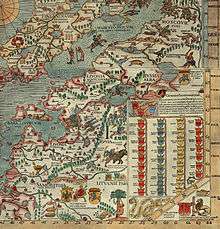 Part of Olaus Magnus' map depicting Lithuania: Lithuanian type of crop trade ships (naves frumentarie) - vytinė is seen close to Vilnius, also beehives protection from the bears(on the right side)
Part of Olaus Magnus' map depicting Lithuania: Lithuanian type of crop trade ships (naves frumentarie) - vytinė is seen close to Vilnius, also beehives protection from the bears(on the right side) Palace of the Grand Dukes of Lithuania in Vilnius. Many European novelties and fashions like opera and Italian or French cuisine reached Lithuania through this Palace.
Palace of the Grand Dukes of Lithuania in Vilnius. Many European novelties and fashions like opera and Italian or French cuisine reached Lithuania through this Palace. Logo of the Lithuanian Culinary Heritage Foundation used to mark the food produced using traditional Lithuanian way.
Logo of the Lithuanian Culinary Heritage Foundation used to mark the food produced using traditional Lithuanian way.
Bread
One of the oldest and most fundamental Lithuanian food products was and is rye bread. Rye bread is eaten every day for breakfast, lunch and dinner. Bread played an important role in family rituals and agrarian ceremonies.[11] Traditionally, the centerpiece of Lithuanian cuisine is dark rye bread (ruginė duona) which is used more often than light wheat breads. The archeological finds reveal that bread in the 9th - 14th centuries in Lithuania was very similar to the current rye bread.[12] The dough is usually based on a sourdough starter, and includes some wheat flour to lighten the finished product. Rye bread is often eaten as an open-faced sandwich, buttered or spread with cheese. It is sometimes flavored with caraway, or with some onion. Traditional bread is baked on sweet flag leaves.
Some varieties of Lithuanian bread contain whole seeds of rye and wheat; this type of bread is referred to as grūdėtoji, i.e. "seeded" bread.
Vegetables and spices

.jpg)
The most commonly used vegetable in Lithuanian recipes is the potato; in its simplest forms, it is boiled, baked, or sauteed, often garnished with dill, but a tremendous variety of potato recipes exist. Potatoes were introduced into Lithuania in the late 18th century, were found to prosper in its climate, and soon became indispensable.
Cucumbers, dill pickles, radishes and greens are quite popular. Beets (burokai) are grown more widely than in other areas of the world, and are often used for making borscht and side dishes. Cabbage is another popular vegetable, used as a basis for soups, or wrapped around fillings (balandėliai). Tomatoes are now available year-round in stores, but those home-grown in family greenhouses are still considered superior.
Lithuanian herbs and seasonings include mustard seed, horseradish (krienai), dill (krapai), caraway seed (kmynai), garlic, bay leaf, juniper berries (kadagio uogos), and fruit essences. Vanilla and pepper were scarce during the Soviet occupation, but were welcomed back after independence. The cuisine is relatively mild.
Foraging: berries and mushrooms, edible wild plants
One of the prides of Lithuanian cuisine is its wide use of wild berries and mushrooms and this foraging tradition is pretty much alive to this day.
Mushrooming is a popular pastime from mid-summer to autumn. As a staple, mushrooms are usually harvested in the forest; occasionally they are purchased at roadside markets, especially on the road in the Dzūkija region from Druskininkai to Vilnius; the purchasing of mushrooms in shops is rare. Despite its status as a delicacy, mushrooms are thought of by many Lithuanians as hard to digest. Dried mushrooms being used as a seasoning. A number of mushroom species are harvested from the wild, including:
- Baravykas – king bolete;
- Voveraitė (literally, "little squirrel"), lepeška (in Dzūkija region) – chanterelle;
- Gudukas, vokietukas, kalpokas, vištelė – gypsy mushroom.
Baravykas is the most valued and sought-after species; the primary usages are drying and marinating. Dried baravykas has a strong pleasant scent and is used as seasoning in soups and sauces. Voveraitė is often used fresh as a seasoning in soups or sauteed. Most common dish of this mushroom is voveraitė sauteed with chopped bulb onions and potatoes. Gudukas, arguably the most locally abundant of edible mushrooms due to its lower popularity, is usually marinated. Other edible mushrooms, such as lepšė (Leccinum scabrum), raudonviršis or raudonikis (literally, "red-topped") (Leccinum aurantiacum), makavykas (Suillus variegatus), šilbaravykis (Xerocomus badius), are more rare, but are also gathered and may be used in the same ways as baravykas.
Wild berries are also gathered or, even more frequently than mushrooms, purchased at roadside markets or shops. Bilberries (mėlynės) and lingonberries (bruknės) are the two most abundant species of wild berries. Cranberries (spanguolės) are valued, but their cultivation is limited to certain boggy areas, such as those adjacent to Čepkeliai Marsh. Sour cranberry or lingonberry jam and sweet bilberry jam are all considered excellent sauces for pancakes (blynai). Lingonberry jam is occasionally used as a dressing for fried chicken or turkey or as a sauce for other savory dishes. Fresh bilberries may be put into a cold milk soup. Wild strawberries (žemuogės) are relatively scarce and are usually gathered for immediate consumption.
- Foraging
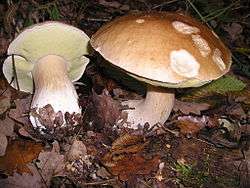 Boletus, the "King of Mushrooms"
Boletus, the "King of Mushrooms"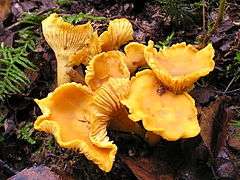 Chanterelles are popular mushrooms in Lithuania
Chanterelles are popular mushrooms in Lithuania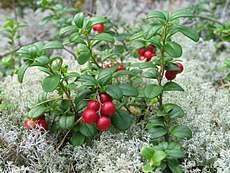 Lingonberry
Lingonberry Bilberry
Bilberry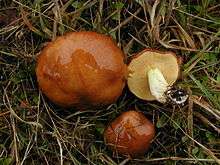 Butter-mushroom
Butter-mushroom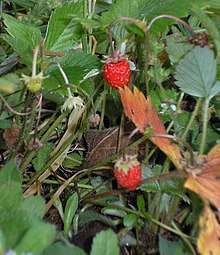 Strawberry
Strawberry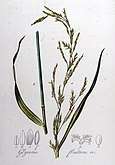 Glyceria fluitans (paprastoji monažolė). The seeds were used for food and mentioned as nature goods of Lithuania Minor along with beeswax, honey, amber and timber.[13]
Glyceria fluitans (paprastoji monažolė). The seeds were used for food and mentioned as nature goods of Lithuania Minor along with beeswax, honey, amber and timber.[13] Pastinaca sativa (paprastasis pastarnokas). Was a popular food before appearance of potatoes. K.Donelaitis in his poem The Seasons promoted growing of parsnips.
Pastinaca sativa (paprastasis pastarnokas). Was a popular food before appearance of potatoes. K.Donelaitis in his poem The Seasons promoted growing of parsnips.
Fruit
Apples, plums, and pears, which grow well in Lithuania, are the most commonly used fruit. Because they cannot tolerate frost, tropical fruit such as citrus, bananas and pineapples must be imported, and hence were used less often in the past; however, these fruits are now becoming more typical and are widely consumed. During the autumn harvest, fruit is often simmered and spiced to create fruit stews (kompots). Gooseberries (agrastai) and currants (serbentai) are widely cultivated; they are sweetened, made into jams and baked goods, and provide a piquant touch to desserts. Small local producers make fine fruit wines from raspberries, and especially blackcurrants; apple icewine is also produced.
Meat
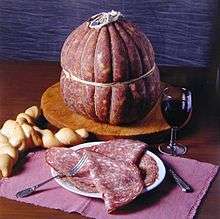
The most frequently used meat is pork, followed by beef, lamb, chicken, turkey, and duck; for immediate consumption it is often grilled, or dusted with breadcrumbs and sauteed, in a dish similar to schnitzel. For bigger gatherings, oven roasts are prepared. The need for meat preservation no longer presents the urgency that it did during the Soviet occupation or previous times of trouble, but many favorite techniques survive, include brining, salting, drying and smoking. There are many varieties of smoked pork, including ham and a soft sausage with a large-grained filling; these are served as a main course or thinly sliced in sandwiches. Skilandis is a popular Lithuanian sausage added to the list of EU's Protected Designations of Origin.
Fish
Freshwater fish with exception of herring was the most popular fish in Lithuania. Fish, such as pike or perch, are often baked whole or stuffed, or made into gefilte fish. Herring is marinated, baked, fried, or served in aspic. Salmon is also a popular dish often served with a cream sauce, vegetables, and rice.
Smoked fish such as eel or bream are popular entrees and appetizers in areas near the Baltic Sea, especially in Neringa.
Crayfish are also popular and are usually eaten in the summertime as delicacy.
Dairy products
Dairy products play an important role in Lithuanian cuisine; curd cheese (similar to cottage cheese) may be sweet, sour, seasoned with caraway, fresh, or cured until semi-soft. Lithuanian butters and cream are unusually rich. Sour cream is so prominent in Lithuanian cuisine, that it is eaten with everything - meat, fish, pancakes, soups, desserts, salads and so on. Lithuanian curd snacks called sūreliai are popular too. Also, a big variety of different soured milk products are available in the supermarkets, though many people still prefer making their own soured milk.
Cheese
Traditional Lithuanian curd cheese has a Protected Geographical Indication (PGI) label.[14] The most popular way of eating Lithuanian non-fermented white cheese is with fresh honey; it can also be cooked with spices and enjoyed with tea. Lithuanians started fermenting cheese around the 16th century in the region of Samogitia. Across Samogitian borders, this cheese was known as Lithuanian cheese. Semi-hard cheese Liliputas in 2015 was included in EU Protected Designation of Origin and Protected Geographical Indication product lists.[15] Hard cheese Džiugas ripens for at least 12 months, is popular among gourmet and being used as dish flavour.
Random list of dishes
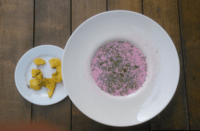
- Bulvinių kukulių sriuba - minced potatoes formed into small balls, and boiled in milk. These are usually made from the same potato mixture used in cepelinai.
- Cabbage soup flavored with carrots, ham, onions, sauerkraut or all of these and boiled with lard.
- Cucumber soup - broth is pureed with cucumbers and sweet or sour cream, often garnished with dill.
- Juka - blood soup from the southern region of Lithuania.
- Lapienė - greens such as sorrel or spinach are braised and added to a creamy broth.
- Sauerkraut soup - often seasoned with pork, carrots, onions, and bay leaves.
- Barščiai - hot borscht (beet soup); it is served uncreamed or blended with sour cream or buttermilk; sometimes chopped Boletus mushrooms are added.
- Šaltibarščiai - cold borscht is a summer soup based on beets and milk kefir or sour milk, colored a shocking pink. It is made with cooked or pickled shredded beets and various other chopped vegetables, such as cucumber, dill, or green onions. Hot boiled potatoes, cold sour cream, and diced hard-boiled eggs are often served alongside to add color, texture, and thermal contrast.
- Vištienos sultinys - chicken broth is always popular, especially for the elderly and ill.
- Kepta duona - black bread fried in oil and rubbed with garlic, often served with beer.and or an alcoholic beverage of some sort
- Įdaryti kiaušiniai - Hard-boiled eggs are split, stuffed and garnished; similar to deviled eggs.
- Įdaryti pomidorai - Tomatoes are cut in half and filled with a savory stuffing.
- Piršteliai prie alaus - These "little fingers" are thin, rolled-up puff pastries served with beer.
- Lašiniai - (non-rendered pork underskin fat with little or no meat, known in Russian and Ukrainian as salo) is a popular appetizer in villages where it is produced locally, and is usually consumed in the form of a sandwich with unbuttered bread and bulb onions or other vegetables.
- Kotletai or Frikadėlės - soft minced meat and/or onion patties, often served with potatoes, sliced cucumber,dill pickle and/or grated beats and a sauce.
- Manų Putra/Košė - Semolina wheat porridge/pudding topped with butter, cinnamon, sugar and/or berries. It is common as a breakfast dish or as a dessert.
- Aspic or meat jelly (šaltiena or košeliena) - many savory foodstuffs are presented in gelatin molds, especially herring; horseradish is often served as a condiment.
- Blynai or Lietiniai, Sklindžiai - although blynai is often translated as pancakes, they are usually more similar to crepes. They are either wafer-thin, as crepes are, or made from a yeast-risen batter, often mixed with grated apple or potato.
- Kėdainių blynai - grated raw potato pancakes, similar to latkes.
- Žemaičių blynai - similar to Kėdainių blynai, made from boiled potatoes and filled with chopped cooked meat
- Lietiniai - large, usually square blintzes made from thin crepes filled with minced meat, cheese with cinnamon, or minced sauteed mushrooms.
- Buckwheat pancakes - traditional dish in Dzūkija
- Balandėliai (little doves) - cabbage leaves stuffed with meat and braised.
- Dešra - sausages are made in many different ways: they may be smoked or fresh, and include pork, beef, potatoes, or barley; in rural areas, blood may be added.
- Didžkukuliai or Cepelinai (zeppelins) - potato dumplings stuffed with meat, mushrooms, or cheese, often garnished with spirgai, fried minced onion and bacon or sour cream.
- Kastinys - sour cream "butter"; sour cream is kneaded and washed until it forms a soft spread. A traditional dish in Samogitia.
- Kibinai - pastry with mutton and onions, a Karaite dish.
- Kukuliai - Potato dumplings similar to gnocchi.
- Koldūnai, Virtiniai, Auselės - these are various kinds of dumplings, filled with minced meat, sausage, cottage cheese, or mushrooms, usually garnished with crumbled fried bacon. They are similar to Polish pierogi or kołduny, but are usually smaller.
- Kugelis (also bulvių plokštainis, the lexically correct non-foreign name, literally "flat potato dish" or banda - this usage predominates in the Dzūkija region) - potato pudding made with grated potatoes and eggs. It is usually served with sour cream or spirgai. Also served with diced bacon and diced onion cooked in the bacon fat.
- Šaltnosiukai (cold little noses) - dumplings filled with lingonberries, not found anywhere outside Lithuania.
- Skilandis or Kindziukas - pig stomach stuffed with meat and garlic and cold-smoked.
- Suktiniai - ("beef birds") - beef or pork is pounded until very thin, filled and rolled up, and braised. An example of this is zrazai, which are Lithuanian or East European beef rolls.[16] See image at right.
- Švilpikai - an oven-baked potato snaps.
- Šiupinys (Hodge-Podge) - a stew made from variety of ingredients - peas, beans, potatoes, meat, rye flour. Various different combinations are preferred in different regions of Lithuania.
- Troškinti rauginti kopūstai - a stew made with sauerkraut and the cook's choice of meats and vegetables.
- Vėdarai - large intestine of a domestic pig stuffed with grated potato mash.
Desserts
Lithuanian-style cakes (pyragas) are often baked in a rectangular pan and sometimes have apple, plum, apricot, or other fruit baked in; they are less frequently iced than is customary in the United States. These cakes are cut into squares for serving. Poppy seed is sometimes used as a swirl filling in dessert bread (Poppy seed roll and šimtalapis) and as a flavoring in other pastries.
For special occasions, torte may be prepared; they often consist of 10 to 20 layers, filled with jam and vanilla, chocolate, mocha, or rum buttercreams; they are lavishly decorated. Lithuanian coffeehouses (kavinė) serve a variety of tortes and pastries to attract evening strollers.
Desserts include:
- Žagarėliai (also known as krustai or chrustai) - Twisted, thin deep-fried pastries dusted with powdered sugar; identical to Scandinavian Klejner cookies, similar to Mexican buñuelo.
- Kūčiukai or šližikai - very small rolls are baked and served with poppyseed milk; this is a traditional Kūčios' (Christmas Eve) dish.
- Ledai - ice cream is served everywhere in the summer.
- Spurgos - a Lithuanian variant of doughnuts, often filled with preserves.
- Šakotis (also called raguotis) - a Lithuanian variant of German baumkuchen, with a very distinctive branching form; it is essentially a poundcake grilled layer by layer.
- Tinginys - prepared with biscuits or crackers, cocoa, butter, sugar and solidified milk
- Skruzdėlynas ("anthill") - consists of individual pastries stacked on top of one another, sprinkled with poppy seeds and glazed with honey and nuts.
Special occasions
- Easter - The intricately painted Easter eggs that were prepared earlier in the week are eaten for breakfast. The diners touch their eggs together as a sort of toast (among the children, this custom sometimes devolves into a smashing contest). Dinner may be roast goose or ham and accompaniments. Dessert is often a cake made to resemble a birch log, or cookies shaped and decorated as mushrooms.
- Birthdays - The family's favorite cake is served. Traditionally in Lithuania the day of the saint after whom one was named was celebrated by the family as well as one's own birth date; for instance, a John would celebrate his name day on St. John's Day (Joninės), June 23.
- Christmas Eve (Kūčios) - Twelve dishes are presented on a table spread with hay and lit by candles. No animal products, including dairy products or eggs, can be consumed as part of this meal. However, fish is permitted and regularly forms part of the meal. This custom is widespread in Catholic Eastern Europe, but traditions vary to different families. It is supposed that rituals and servicing of the Christmas Eve table reflects the most ancient Lithuanian traditions.
- Weddings - The widest possible variety of courses are served. A special bread is sometimes baked and adorned with flowers and bird-shaped decorations, or a šakotis is decorated. The ideal Lithuanian wedding lasts at least two days, so a great deal of cooking and baking goes on.
- Funerals - The bereaved family usually hosts a dinner for all the mourners at a restaurant or other similar venue.
- Informal gatherings and cocktail parties - The hosts often serve small open-face sandwiches, similar to those at a Scandinavian smorgasbord, topped with smoked fish, sausage, cucumbers, and so forth. Flavored vodkas, which may have been concocted with fruits and herbs according to the host's or hostess's own family recipe, may be served.
Drinks
Beer
Alus (beer) is extremely popular throughout the country, especially again since restoration of the Independence in 1990. Several Lithuanian beers have won international awards. Local breweries are enjoying a renaissance. Beer is the most common alcoholic beverage. Lithuania has a long farmhouse beer tradition, first mentioned in 11th century chronicles. Beer was brewed for ancient Baltic festivities and rituals.[17] Lithuania is not very well known for its beer worldwide, but it is one of the few countries in Europe to have an independent beer tradition in which breweries do not simply brew beers in styles developed elsewhere. Traditional farmhouse brewing has survived into the present day in Lithuania, and during Soviet times such brewing started to be expanded to a larger scale. After independence this process gathered speed, and soon there were more than 200 breweries in the country. Many of these have since gone out of business, but Lithuania still has about 80 breweries, of which perhaps 60-70 produce beers in styles unknown in the rest of the world. Some of these are very close to the traditional brews made by farmers, while others have developed out of that tradition as a consequence of the growth of the traditional brewers into reasonably large regional breweries.
Farmhouse brewing survived to a greater extent in Lithuania than anywhere else, and through accidents of history the Lithuanians then developed a commercial brewing culture from their unique farmhouse traditions.[18] Lithuania is top 5 by consumption of beer per capita in Europe in 2015, counting 75 active breweries, 32 of them are microbreweries.[19]
The microbrewery scene in Lithuania has been growing in later years, with a number of bars focusing on these beers popping up in Vilnius and also in other parts of the country. Local beers have started to attract international attention after beer bloggers discovered the country, inspiring a major feature article in Beer Connoisseur magazine, prompting the New York Times to list Lithuania as one of the 42 places to visit in 2013 on the strength of the village beers. Beer routes are organized through the main breweries in northern Lithuania.
Midus
Midus is said to be the most ancient Lithuanian alcoholic beverage; it is a variety of mead made from honey. Balts were making midus for thousands of years.
Other
- Arbata (tea) - chamomile, rosehip, and other herbal teas are popular as well as black tea. Many herbal infusions are used for medicinal purposes.
- Gira (kvass) is a non alcoholic beverage made by the natural fermentation of wheat, rye, or barley bread, sometimes flavoured with fruit, berries, raisins or birch sap; it is similar to Russian or Ukrainian kvass. Those brewed from rye bread and from caraway seed are popular and distributed in glass bottles. There is also a carbonated soft drink known as gira, which is distributed in plastic bottles, but it shares neither taste nor production technology with the original beverage.
- Degtinė ("the burn") is the Lithuanian version of vodka, made from rye, wheat or potatoes. Produced domestically, its quality ranges from basic to triple-distilled.
- Kava (coffee) is brewed in espresso makers at home, or with espresso machines in cafes. It is quite strong, and usually sweetened. Coffeehouses (kavinė) can be found not only on every street corner in towns but at highway rest stops and at every point of interest.
- Starka, an aged vodka, as well as Krupnikas, a honey liqueur, are traditional drinks dating from the Polish-Lithuanian Commonwealth in the 16th - 18th centuries. Today, genuine Starka is only produced in Poland, and Lithuanian Starka is rather a form of trauktinė.
- Trauktinė (a bitter) is a strong herbal vodka; there are many varieties. It is also used as a traditional medicine. Trejos devynerios ("999"), steeped with 27 different herbs, is one of the best known.
Contemporary cuisine and restaurants

Currently Lithuania is affected by modern cuisine trends - fusion, new nordic, craft beer, craft food. Restaurant culture is most advanced in bigger cities - Vilnius, Kaunas, Klaipėda. Yearly 30 best Lithuanian restaurants being selected by the Good Food Academy (Gero maisto akademija).[20]
See also
Footnotes
- ↑ "Kokią įtaką Lietuvos virtuvei padarė prancūzai?". www.15min.lt (in Lithuanian). Retrieved 26 March 2018.
- ↑ Lissau, I., et al., Body mass index and overweight in adolescents in 13 European countries, Israel, and the United States (Abstract), Archives of Pediatrics & Adolescent Medicine, 2004 January; 158(1):27-33.
- ↑ "The best restaurants in the Nordics". www.whiteguide-nordic.com. Retrieved 4 April 2018.
- ↑ "P. CORNELI TACITI DE ORIGINE ET SITV GERMANORVM". www.thelatinlibrary.com. Retrieved 26 May 2018.
Frumenta ceterosque fructus patientius quam pro solita Germanorum inertia laborant.
- ↑ Orosius, Paulus. [from old catalog],Alfred, King of England, 849-899, tr,Bosworth, Joseph, 1789-1876, ed,Hampson, Robert Thomas, 1793-1858. [from old catalog]. "King Alfred's Anglo-Saxon version of the Compendious history of the world by Orosius. Containing,--facsimile specimens of the Lauderdale and Cotton mss., a preface describing these mss., etc., an introduction--on Orosius and his work; the Anglo-Saxon text; notes and various readings; a literal English translation, with notes; Mr. Hampson's Essay on King Alfred's geography, and a map of Europe, Asia, and Africa, according to Orosius and Alfred" (ebook). archive.org. p. 101. Retrieved 17 May 2018.
Ƿæt Eastland is swyðe mycel, and ƿær bið swyðe manig burh, and on ælcere byrig bið cyningc ; and ƿær bið swyðe mycel huning, and fiscað ; and se cyning and ƿa ricostan men drincað myran meolc, and ƿa ƿeōwan drincað medo. Ƿær bið swyðe mycel gewinn betweonan him ; and ne bið ðær nænig ealo gebrowen mid E'stum, ac ƿær bið mēdo genōh. And ƿær is mid E'stum ðeaw, ƿonne ƿær bið man dead, ƿæt he lið inne unforbærned mid his magum and freondum monað, - gehwilum twegen : and ƿa [cyningas] and ƿa oðre heah-ðungene men, swa micle lencg swa hi maran speda habbað, hwilum healf-gēar, ƿæt hi beoð unforbærned ; and licgað bufan eorðan on hyra husum : and ealle ƿa hwile, ƿe ƿæt lic bið inne, ƿær sceal beon gedrync, and plega, oð ðonne dæg, ƿe hi hine forbærnað.
- ↑ "Istorikė Jolanta Karpavičienė: „Valdovų sutuoktinės buvo tikros europietės"". ukininkopatarejas.lt. Retrieved 4 May 2018.
- ↑ "Sunkus Kotrynos Jogailaitės kelias į laimę". www.lzinios.lt. Retrieved 4 June 2018.
Kaip jau žinoma, Kotrynos Jogailaitės valdymo metais Karalių rūmai Stokholme buvo perstatyti renesanso stiliumi, būtent ši karalienė švedus išmokė naudotis šakute, jai atvykus protestantas vyras žmonai pastatė katalikų koplyčią.
- ↑ Laužikas, Rimvydas (2014). Istorinė Lietuvos virtuvė: Maistas ir gėrimai Lietuvos Didžiojoje Kunigaikštystėje. Vilnius: Briedis. pp. 81–82. ISBN 978-9955-26-463-7.
- ↑ "Kada Lietuvoje atsirado bulvės?". m.ldkistorija.lt. Retrieved 5 May 2018.
- ↑ "Archaeological Finds at the Palace of the Grand Dukes of Lithuania". www.valdovurumai.lt. Retrieved 11 June 2018.
During the archaeological digs many serving knives were found. The knife was one of the basic table implements. Men and women carried them in decorative sheaths attached to their belts. The handles of the knives were made of wood, bone, or horn and were variously decorated. Some of the knives have a maker’s mark on their blades. One of the knives was made of steel and the maker’s mark was a nonferrous (colored-metal) encrustation. The wooden handle was decorated with zoomorphic ornaments.
- ↑ "LITHUANIAN TRADITIONAL FOODS - BREAD". www.lnkc.lt. Retrieved 25 March 2018.
- ↑ "Ką lietuviai valgė IX–XIV amžiuje: VU archeologės ištyrė pirmą lietuvišką duoną". www.15min.lt. Retrieved 14 June 2018.
- ↑ "Pamirštieji vietiniai grūdai". kulinarinispaveldas.blogspot.com. Retrieved 4 July 2018.
jos minimos, vardinant Prūsijos Karalystės Lietuviškosios dalies gamtos turtus, greta medaus, gintaro, medienos, odos, vaško.
- ↑ "Traditional "Senolių Lietuviškas"". www.luksiupienine.lt. Retrieved 17 April 2018.
- ↑ "Authentic Lithuanian Cuisine You Can Find In Any Supermarket". curioustovisit.com. Retrieved 17 April 2018.
- ↑ Food.com Zrazai (Lithuanian Beef Rolls)} by duonyte
- ↑ "Alus – apeiginis baltų gėrimas" (PDF). www.llti.lt. p. 18. Retrieved 22 March 2018.
- ↑ "Lithuanian beer - A rough guide" (PDF). www.garshol.priv.no. p. 5. Retrieved 22 March 2018.
- ↑ "Beer statistics - 2016 edition" (PDF). www.brewersofeurope.org. Retrieved 25 March 2018.
- ↑ "30 best restaurants in Lithuania". 30bestrestaurants.lt. Retrieved 9 August 2018.
Further reading
- (In Lithuanian) Rimvydas Laužikas. Istorinė Lietuvos virtuvė: maistas ir gėrimai Lietuvos Didžiojoje Kunigaikštystėje. Vilnius: Briedis, 2014. ISBN 978-9955-26-463-7
- (In Lithuanian) Prie stalo visa Lietuva: mityba ir maisto kultūra nuo seniausių laikų iki iki šių dienų. Kaunas: Terra Publica,2015. ISBN 978-609-8090-89-5
- (In Lithuanian) Lietuvos kulinarinis paveldas Lithuanian culinary heritage - R.Laužikas blog
External links
| Wikimedia Commons has media related to Cuisine of Lithuania. |
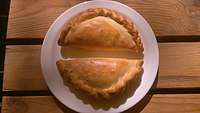
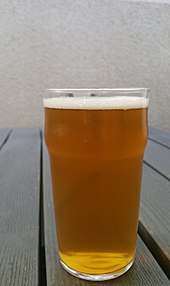
.jpg)
